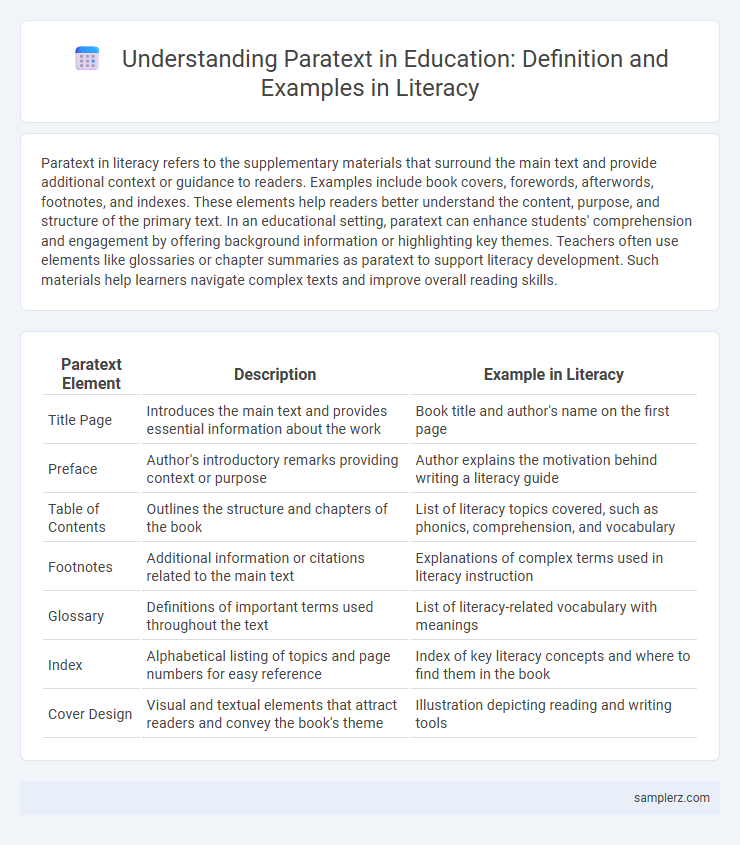Paratext in literacy refers to the supplementary materials that surround the main text and provide additional context or guidance to readers. Examples include book covers, forewords, afterwords, footnotes, and indexes. These elements help readers better understand the content, purpose, and structure of the primary text. In an educational setting, paratext can enhance students' comprehension and engagement by offering background information or highlighting key themes. Teachers often use elements like glossaries or chapter summaries as paratext to support literacy development. Such materials help learners navigate complex texts and improve overall reading skills.
Table of Comparison
| Paratext Element | Description | Example in Literacy |
|---|---|---|
| Title Page | Introduces the main text and provides essential information about the work | Book title and author's name on the first page |
| Preface | Author's introductory remarks providing context or purpose | Author explains the motivation behind writing a literacy guide |
| Table of Contents | Outlines the structure and chapters of the book | List of literacy topics covered, such as phonics, comprehension, and vocabulary |
| Footnotes | Additional information or citations related to the main text | Explanations of complex terms used in literacy instruction |
| Glossary | Definitions of important terms used throughout the text | List of literacy-related vocabulary with meanings |
| Index | Alphabetical listing of topics and page numbers for easy reference | Index of key literacy concepts and where to find them in the book |
| Cover Design | Visual and textual elements that attract readers and convey the book's theme | Illustration depicting reading and writing tools |
Understanding Paratext in Literacy
Paratext in literacy includes elements such as book covers, titles, prefaces, and illustrations that provide context and guide readers' interpretation of the text. Understanding paratext helps educators teach students how these features influence meaning and engage with the text more critically. Incorporating paratext analysis in literacy education enhances comprehension and develops critical thinking skills.
The Role of Book Covers as Paratext
Book covers function as crucial paratextual elements in literacy by framing readers' expectations and guiding interpretation before the first page is read. They incorporate visual design, typography, and imagery that signal genre, tone, and target audience, thus enhancing engagement and comprehension. Studies indicate that well-designed book covers increase selection rates and can positively influence literacy motivation in educational settings.
Forewords and Their Impact on Reader Engagement
Forewords in literacy serve as paratextual elements that frame a reader's understanding and anticipation of the main text, enhancing engagement by providing context, author credibility, and thematic insight. These introductory sections often influence readers' interpretations and set expectations, fostering a deeper connection with the content. Studies in educational literacy reveal that well-crafted forewords significantly boost reader motivation and comprehension, contributing to overall learning effectiveness.
How Prefaces Shape Text Interpretation
Prefaces in literacy act as critical paratexts by framing the readers' engagement and interpretation of a text, often providing authorial intent, historical context, or thematic guidance. Educators emphasize analyzing prefaces to enhance comprehension, as these sections influence readers' understanding by highlighting key concepts and narrative perspectives. This metatextual element plays a pivotal role in literary education by shaping critical thinking and close reading skills.
Marginalia: An Interactive Paratextual Element
Marginalia, a key interactive paratextual element in literacy, enhances comprehension by allowing readers to annotate texts with personal notes, questions, and reflections. These annotations create a dynamic dialogue between the reader and the text, fostering deeper engagement and critical thinking. Digital platforms increasingly incorporate marginalia features to support collaborative learning and active reading strategies in educational settings.
Illustrations and Visual Paratexts in Literacy
Illustrations and visual paratexts in literacy enhance comprehension by providing contextual cues that support textual meaning, such as images accompanying stories or informational graphics in textbooks. Visual elements like headings, captions, and icons guide readers through content and help scaffold understanding, especially for emerging readers. These paratextual features foster engagement and aid in decoding complex information, improving literacy acquisition and retention.
The Influence of Titles and Subtitles
Titles and subtitles serve as critical paratextual elements that frame readers' understanding and guide their interpretation of literacy texts. Effective titles capture attention and provide insight into the content, while subtitles offer clarification and emphasize key themes or perspectives. These paratextual markers influence comprehension and engagement by setting expectations and highlighting the author's focus.
Footnotes and Endnotes in Educational Texts
Footnotes and endnotes in educational texts serve as essential paratextual elements that enhance literacy by providing supplementary information, clarifications, and source references without disrupting the main narrative. These annotations support critical thinking and deeper comprehension, allowing students to explore additional contexts and verify the accuracy of the information presented. Incorporating footnotes and endnotes encourages academic rigor and facilitates effective research skills crucial for literacy development.
Publisher’s Blurbs: Guiding Reader Expectations
Publisher's blurbs serve as paratexts by offering concise summaries and persuasive language that shape readers' anticipations before engaging with the text. These blurbs often highlight key themes, author credentials, or critical acclaim, effectively guiding literacy development through pre-reading strategies. By framing the narrative context, publisher's blurbs enhance comprehension and motivate reading engagement.
Digital Paratexts in Modern Literacy Education
Digital paratexts in modern literacy education include interactive e-books, hyperlinks, and multimedia annotations that extend traditional texts by providing contextual information and enhancing comprehension. These digital elements guide readers through complex narratives and support critical thinking by embedding definitions, translations, and visual aids directly within the text. Integrating digital paratexts fosters multimodal literacy skills essential for navigating contemporary information-rich environments.

example of paratext in literacy Infographic
 samplerz.com
samplerz.com